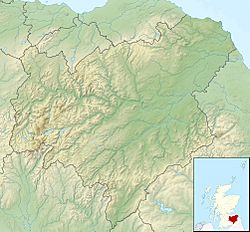Mire Loch facts for kids
Quick facts for kids Mire Loch |
|
|---|---|

Seen from the high ground to the NW
|
|
| Location | Scottish Borders, Scotland |
| Coordinates | 55°54′40″N 2°08′28″W / 55.91111°N 2.14111°W |
| Type | freshwater loch, reservoir |
| Basin countries | United Kingdom |
| Max. length | 600 m (2,000 ft) |
| Max. width | 50 m (160 ft) |
| Surface area | 3 ha (7.4 acres) |
| Surface elevation | 30 m (98 ft) |
Mire Loch is a freshwater loch (which is a Scottish word for a lake) found on St Abb's Head in the Scottish Borders, Scotland. It's about a kilometre northwest of the village of St. Abbs. This loch is on land owned by the National Trust for Scotland (NTS). It is about 600 metres long and 50 metres wide at its widest point.
The Story of Mire Loch
Mire Loch wasn't always a loch. It used to be a marshy, boggy area. This area was part of a natural crack in the land called the St. Abbs Head Fault. This fault separated the hard volcanic rocks of St. Abbs Head from the softer, layered rocks of the mainland. Rainwater from the higher ground on both sides flowed into this valley, creating the boggy area that eventually drained into the sea.
Around the year 1900, people decided to change this marshy land into a fun place for activities. They built a dam to create a freshwater loch. This new loch was used for angling (fishing) and waterfowl hunting. A nine-hole golf course was also built nearby. The golf course is no longer used, but you can still see some signs of the old greens and tees. A boat house was also built on the loch, but it's now old and falling apart, with most of its roof missing.
Wildlife and Visitors Today
Today, Mire Loch is a very important part of the St. Abbs Head National Nature Reserve. It's a safe home for many freshwater birds. You might see birds like little grebes, reed buntings, herons, mute swans, moorhens, and sedge warblers here. The tall reeds around the edges of the loch give these birds shelter and food, especially for nesting birds and those migrating in spring and autumn. In early summer, hundreds of herring gulls and kittiwakes come to bathe in the loch's waters.
In recent years, the NTS has planted nearly 1000 trees around the loch. These trees help provide more cover for migrating birds. Most of these trees are on the southwest shore, in a special area dedicated to a diver who sadly passed away off St. Abbs Head in 1981.
The loch is also home to eels, perch, and stickleback fish. It's also a breeding spot for frogs and toads. There are footpaths around the loch's shores, and the NTS encourages walkers to explore the loch during their visit to St. Abb's Head. Just be aware that the paths can get quite muddy after it rains! The loch has a special stepped outflow that flows for only a few metres before going underground into a man-made drain. From there, the water travels underground to the North Sea, which is only about 500 metres to the southeast.



